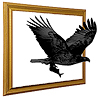| |

Emerging Archaeopteryx, by Darryl Wheye
Archaeopteryx as if rising from the
Berlin specimen, shows the flight-worthy feathers of this toothed
“missing link”.
|
Current Board
has vacancies. If you're interested, please contact darrylw@stanford.edu.
Founding Board
Tony Angell, naturalist, artist, and author
Paul R. Ehrlich, Bing Professor of
Population Studies, Department of
Biology, Stanford University
Donald Kennedy, President emeritus,
Woods Senior Fellow, Stanford
University
Pamela Meadowcroft, research psychologist,
specializing in nonprofit service devel-
and evaluation
Darryl Wheye, artist and author, curator
Our nonprofit also includes an advisory council and a group of affiliated artists, scientists and
interested parties.
|

Bat-eared Fox Portrait, by Carel Brest van Kempen
Termite specialists, these foxes, have exceptional teeth and
excavate complex tunnel networks.
|
| |
Our nonprofit public benefit corporation is organized and operated for charitable and educational purposes. These purposes are discussed in Humans, Nature, and Birds: Science Art from Cave Walls to Computer Screens*, which was co-authored by board members Wheye and Kennedy, introduced by board member Ehrlich, and includes examples by former board members Angell and Brest van Kempen.
*Published with assistance from the Alfred P. Sloan Foundation’s Public Understanding of Science and Technology Program. |
to raise the prominence of
Science Art and the benefits of
combining the accuracy of
science with the evocative
power of art
and
to advocate the use of Science
Art to inform viewers about
nature and encourage the
sustainable use of resources |
| |
The aims of
SCIENCE ART-NATURE are:
- to show how Science Art informs viewers about nature so that evaluating works through a science lens becomes more automatic
- to encourage the use of Science Art so that the importance of maintaining the vital services nature supplies to society is better understood
- to promote collaboration among scientists and artists so that the production of Science Art is optimally informative, timely, and directed as much as possible toward achieving a sustainable society
- to bridge science and art by raising the visibility of Science Art and those who produce it so that opportunities expand for Science Art to be utilized in public spaces, in publications, in exhibits, and online
|

Detail from a poster produced for our
second online Science Art exhibit. All virtual exhibits remain accessible through our website.
|
.
The value of SCIENCE ART …
From the perspective of a scientist:
Science Art can help the public become better informed about and more comfortable with scientific issues important to them.
From that of an artist:
Science Art, through the creative and original designs of a skilled artist interpreting nature, can advance human understanding as it provides aesthetic pleasure.
Or that of a teacher:
Science Art can teach students some elements of analysis by extracting the scientific meaning and significance of the art.
Or a student:
Science Art can encourage the exploration of nature, the recognition of scientific principles, and the importance of the 30,000-year pictorial record.
Or an art lover:
Science Art can expand the way we look at and appreciate the art. |
 Science Art-Nature
Science Art-Nature Science Art-Nature
Science Art-Nature